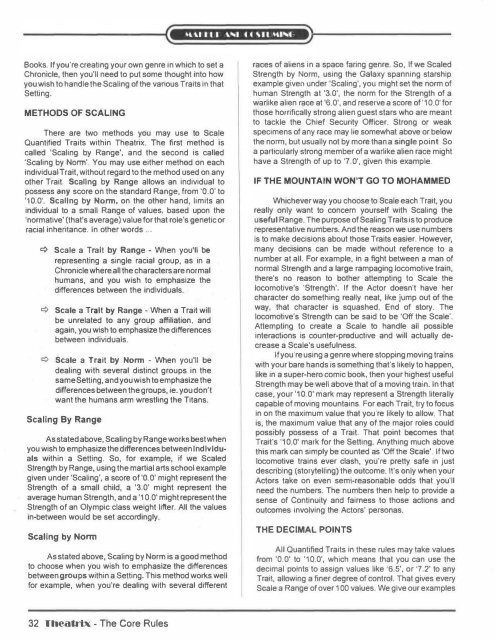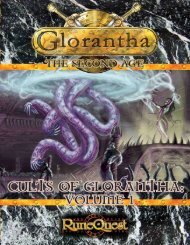Untitled - Index of - Free
Untitled - Index of - Free
Untitled - Index of - Free
You also want an ePaper? Increase the reach of your titles
YUMPU automatically turns print PDFs into web optimized ePapers that Google loves.
Books If you're creating your own genre in which to set a<br />
Chronicle, then you'll need to put some thought into how<br />
you wish to handle the Scaling <strong>of</strong> the various Traits in that<br />
Setting.<br />
METHODS OF SCALING<br />
There are two methods you may use to Scale<br />
Quantified Traits within Theatrix. The first method is<br />
called 'Scaling by Range', and the second is called<br />
'Scaling by Norm' You may use either method on each<br />
individual Trait, without regard to the method used on any<br />
other Trait. Scaling by Range allows an individual to<br />
possess any score on the standard Range, from '0.0' to<br />
'10.0'. Scaling by Norm, on the other hand, limits an<br />
individual to a small Range <strong>of</strong> values, based upon the<br />
'normative' (that's average) value for that role's genetic or<br />
racial inheritance. In other words ...<br />
Scale a Tralt by Range - When you'll be<br />
representing a single racial group, as in a<br />
Chronicle where all the characters are normal<br />
humans, and you wtsh to emphasize the<br />
differences between the individuals.<br />
Scale a Trait by Range - When a Trait will<br />
be unrelated to any group affiliation, and<br />
again, you wish to emphasize the differences<br />
between individuals.<br />
Q Scale a Trait by Norm - When you'll be<br />
dealing with several distinct groups in the<br />
same Setting, and you wish to emphasize the<br />
differences between the groups, ie. you don't<br />
want the humans arm wrestling the Titans.<br />
Scaling By Range<br />
As stated above, Scaling by Range works best when<br />
you wish to emphasize the differences between individu<br />
als within a Setting. So, for example, if we Scaled<br />
Strength by Range, using the martial arts school example<br />
given under 'Scaling', a score <strong>of</strong> '0.0' might represent the<br />
Strength <strong>of</strong> a small child, a '3.0' might represent the<br />
average human Strength, and a '1 0.0' might represent the<br />
Strength <strong>of</strong> an Olympic class weight lifter. All the values<br />
in-between would be set accordingly.<br />
Scaling by Nonn<br />
As stated above, Scaling by Norm is a good method<br />
to choose when you wish to emphasize the differences<br />
between groups within a Setting. This method works well<br />
for example, when you're dealing with several different<br />
32 Theab1x - The Core Rules<br />
races <strong>of</strong> aliens in a space faring genre So, If we Scaled<br />
Strength by Norm, using the Galaxy spanning starship<br />
example given under 'Scaling', you might set the norm <strong>of</strong><br />
human Strength at '3.0', the norm for the Strength <strong>of</strong> a<br />
warlike alien race at '6.0', and reserve a score <strong>of</strong> '10.0' for<br />
those horrifically strong alien guest stars who are meant<br />
to tackle the Chief Security Officer. Strong or weak<br />
specimens <strong>of</strong> any race may lie somewhat above or below<br />
the norm, but usually not by more than a single point So<br />
a particularly strong member <strong>of</strong> a warlike alien race might<br />
have a Strength <strong>of</strong> up to '7 0', given this example.<br />
IF THE MOUNTAIN WON'T GO TO MOHAMMED<br />
Whichever way you choose to Scale each Trait, you<br />
really only want to concern yourself with Scaling the<br />
useful Range. The purpose <strong>of</strong> Scaling Traits is to produce<br />
representative numbers. And the reason we use numbers<br />
Is to make decisions about those Traits easier However,<br />
many decisions can be made without reference to a<br />
number at all. For example, In a fight between a man <strong>of</strong><br />
normal Strength and a large rampaging locomotive tram,<br />
there's no reason to bother attempting to Scale the<br />
locomotive's 'Strength'. If the Actor doesn't have her<br />
character do something really neat, like jump out <strong>of</strong> the<br />
way, that character is squashed. End <strong>of</strong> story. The<br />
locomotive's Strength can be said to be 'Off the Scale'<br />
Attempting to create a Scale to handle all possible<br />
interactions is counter-productive and will actually de<br />
crease a Scale's usefulness.<br />
If you're using a genre where stopping moving trams<br />
with your bare hands is something that's likely to happen,<br />
like in a super-hero comic book, then your highest useful<br />
Strength may be well above that <strong>of</strong> a moving train. In that<br />
case, your '1 0.0' mark may represent a Strength literally<br />
capable <strong>of</strong> moving mountains. For each Trait, try to focus<br />
in on the maximum value that you're likely to allow. That<br />
is, the maximum value that any <strong>of</strong> the major roles could<br />
possibly possess <strong>of</strong> a Trait. That point becomes that<br />
Trait's '10.0' mark for the Setting. Anything much above<br />
this mark can simply be counted as 'Off the Scale' If two<br />
locomotive trains ever clash, you're pretty safe in just<br />
describing (storytelling) the outcome. It's only when your<br />
Actors take on even semi-reasonable odds that you'll<br />
need the numbers. The numbers then help to provide a<br />
sense <strong>of</strong> Continuity and fairness to those actions and<br />
outcomes involving the Actors' personas.<br />
THE DECIMAL POINTS<br />
All Quantified Traits m these rules may take values<br />
from '0.0' to '10.0', wh1ch means that you can use the<br />
decimal points to assign values like '6.5', or '7 2' to any<br />
Trait, allowing a finer degree <strong>of</strong> control. That gives every<br />
Scale a Range <strong>of</strong> over 1 00 values. We give our examples



